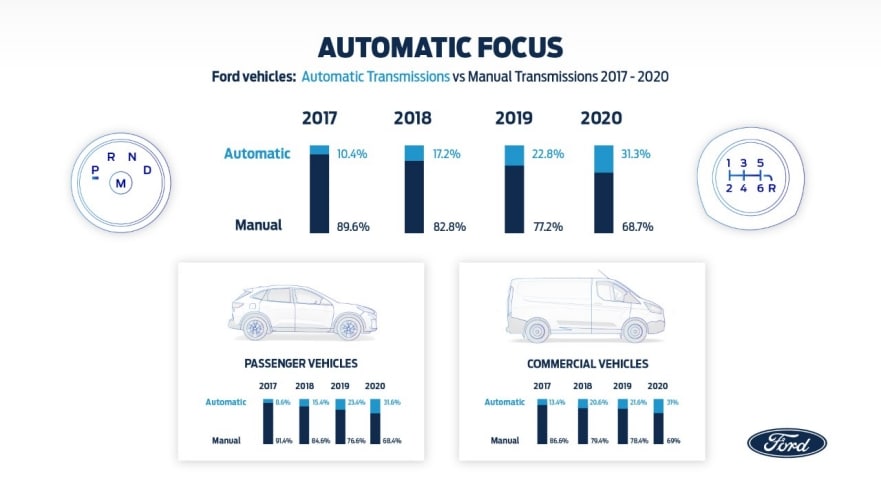COLOGNE, Germany, July 13, 2020 – More and more European drivers are choosing vehicles with automatic transmissions, according to new sales data from Ford.
In the last three years alone, the number of cars and vans Ford has sold with an automatic transmission has more than tripled from 10.4 per cent in 2017 to 31.3 per cent during the first month of 2020. 1
“Among the many benefits of automatic transmissions are that they enable drivers to enjoy the very latest driver assist technology, making everything, from parking to stop-start traffic, easier and more comfortable,” said Roelant de Waard, vice president, Marketing, Sales & Service, Ford of Europe. “We expect to see this trend continue as in the future more and more people move into electric vehicles — establishing automatic transmissions as the norm.”
Ford has offered automatic transmissions for almost 70 years. But today’s sophisticated technology is a far cry from the pioneering Ford-O-Matic that offered just three forward gears.
From reducing cabin noise to helping alleviate car sickness, modern day automatic transmissions offer many benefits. These include facilitating technologies that enable drivers, when using Adaptive Cruise Control, to pull away automatically after coming to a complete halt in stop-start traffic – or to park at the push of a button. 2
The FordPass app also enables drivers of select Ford vehicles with automatic transmission to start the engine remotely, useful for climatising the cabin to a comfortable temperature and for de-icing the windscreen on cold mornings. 3
Small and medium cars driving trend
The trend is in part being driven by the increasing number of drivers selecting small- and medium-sized cars with an automatic transmission.
Ford cars that are increasingly being specified with automatic transmissions include the Focus, with 30.9 per cent of models sold with an automatic transmission in January of this year compared with 7 per cent of models in 2017.
Fiesta and Puma models can also now be specified with an automatic transmission that offers fuel efficiency improvements of up to 15 per cent compared to the equivalent previous Fiesta model. 4
Automatic vans on the rise
Similarly, when it comes to vans, 31 per cent of Ford commercial vehicles sold in January incorporated automatic transmissions, compared with 13.4 per cent in 2017.
During the same month, 19 per cent of Transit models sold were equipped with automatic transmissions compared with 4.7 per cent of models in 2017.
In 2019, across the five big European markets, the highest proportion of Ford vehicles sold with automatic transmissions were for Germany, followed by for France, the U.K., Spain and Italy.
The road ahead
Automatic transmissions point towards an increasingly electrified future with cars that do not require drivers to make gear changes – and beyond that, the introduction of the self-driving car.
The new all-electric Mustang Mach-E can actually be driven with one pedal, as the regenerative braking slows the car to such an extent when the accelerator is lifted that the brake pedal is rarely needed.
# # #
1. Vehicles offering automatic transmissions included in the data analysis of all sales channels from 20 countries in Europe are: C-MAX, EcoSport, Fiesta, Focus, Galaxy, Mondeo, Mustang, Ranger, S‑MAX, Tourneo Connect, Tourneo Custom, Transit, Transit Connect and Transit Custom. Edge and Kuga were excluded as the transmission data was not fully available. The data analysis includes a small percentage of “unknown”, where the transmission data was not available for some vehicles. The unknown figures are 10.6% (2017), 4.8% (2018), 0.7% (2019), 0.9% (2020). 2020 data includes January.
2. If a stop is longer than three seconds, driver must intervene and press “RES” button or accelerator pedal to resume system operation. Driver-assist features are supplemental and do not replace the driver’s attention, judgement and need to control the vehicle.
3. Remote start feature available in regions where permitted by law. The key must be present inside the vehicle for it to be driven.
4. The declared fuel/energy consumptions, CO2-emissions and electric range are determined according to the technical requirements and specifications of the European Regulations (EC) 715/2007 and (EU) 2017/1151 as last amended. Light Duty Vehicle type-approved using the World Harmonised Light Vehicle Test Procedure (WLTP) will have fuel/energy consumption and CO2-emission information for New European Drive Cycle (NEDC) and WLTP. WLTP will fully replace the NEDC latest by the end of the year 2020. The applied standard test procedures enable comparison between different vehicle types and different manufacturers. During NEDC phase-out, WLTP fuel consumption and CO2 emissions are being correlated back to NEDC. There will be some variance to the previous fuel economy and emissions as some elements of the tests have altered, so the same car might have different fuel consumption and CO2 emissions.
Fiesta
|
Power (PS)
|
CO2 from
(g/km NEDC)
|
Fuel consumption from (l/100 km NEDC)
|
CO2 from (g/km WLTP)
|
Fuel consumption from (l/100 km WLTP)
|
1.0-litre EcoBoost
7-speed auto
|
125
|
104
|
4.6
|
127
|
5.6
|
Puma
|
Power (PS)
|
CO2 from
(g/km NEDC)
|
Fuel consumption from (l/100 km NEDC)
|
CO2 from (g/km WLTP)
|
Fuel consumption from (l/100 km WLTP)
|
1.0-litre EcoBoost
7-speed auto
|
125
|
110
|
4.9
|
137
|
6.0
|

